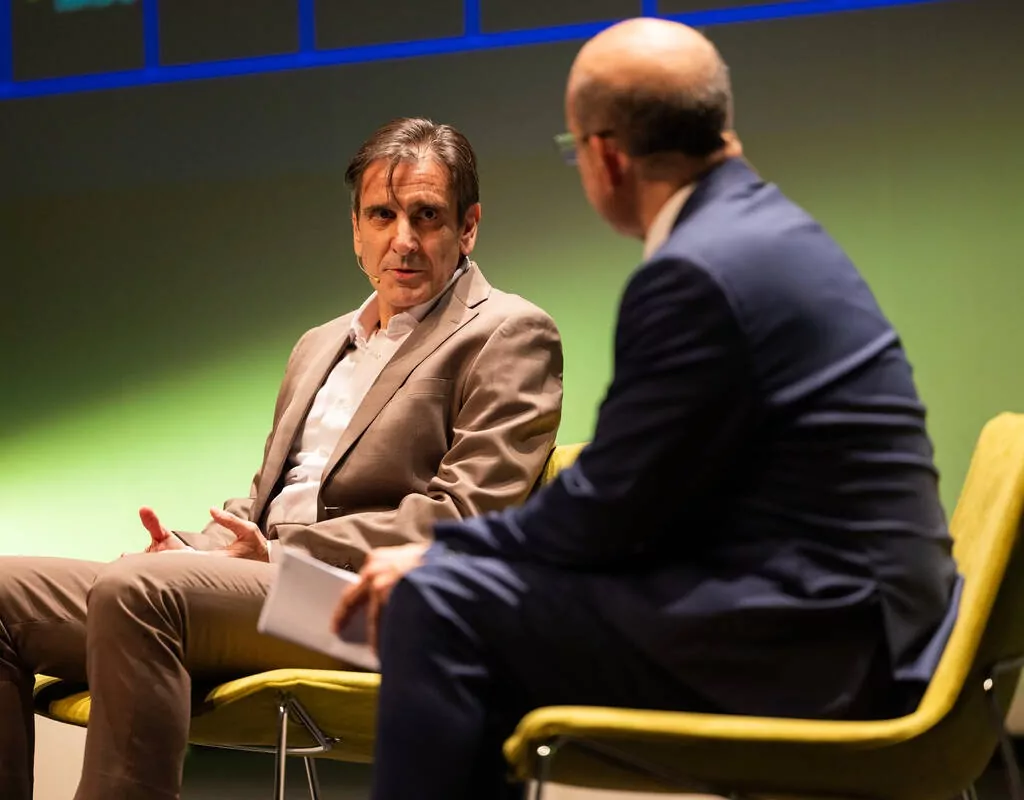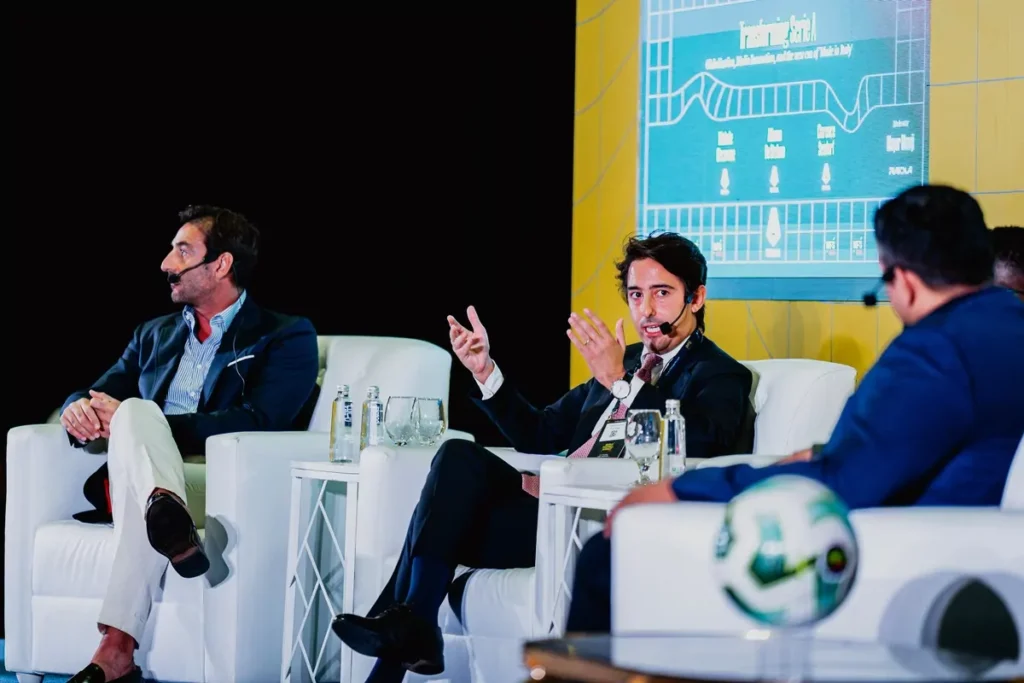As international leagues like LALIGA, Serie A, and the Roshn Saudi League navigate the new framework of an ever-developing industry, their experts believe that storytelling might be the key to luring the attention of a new, younger generation of fans around the globe
There are approximately 830 million fans of the Italian pro football league Serie A all over the world, but only 30 million of them are actually based in Italy. And yet, it wasn’t until three years ago that its management realized that, if they actually wanted to grow, they needed to be focusing their efforts not only in their home country, as they traditionally had, but in the whole world. And they are not the only competition organizers that, in recent years, have come to a similar realization: if a league wants to maintain its reach and power in a new social landscape, tradition is not going to cut it anymore.
The way the world consumes and understands football has indeed changed drastically, to the point where it is not the same as it was fifteen years ago. As LALIGA President Javier Tebas put it during the 2023 European Edition of World Football Summit, “The economic field is completely different, and the framework for selling audiovisual rights and the channels for digital revenues have nothing to do with what they were then.” And, in order to stay relevant within this context, leagues internationally are trying to develop and implement new, global strategies that are not dependent solely on the quality of the game or its stars.
“To build a great league, you indeed have to have great players”, added Tebas, “but that’s not enough. In terms of branding, you have to make your clubs known and you have to tour a lot; you have to work with your audiovisual rights and try to be present in as many countries as possible and be well positioned. Because if you have very good players but they don’t talk about you, then you will never be able to become one of the big leagues.” The question is: how do we get people talking? Well, let us tell you a story.
HOW THE SERIE A APPROACHES ITS GLOBAL STRATEGY
When Serie A realized they were not leveraging its assets to its fullest potential, the club voted on a big investment to develop a new strategy. They knew people had “great love and a powerful bond” with their clubs, which included AC Milan, Juventus, Inter, Roma, and Napoli, but that love was not coming just from Italy. There were still those previously mentioned 800 million fans worldwide to which they were not fully catering to. And so they set out to find what was the best way to reach them.
“We are in an era where our main competitors are not the Premier League or LALIGA”, said Michele Ciccarese, Commercial & Marketing Director at Serie A, during a panel in the 2023 Asian Edition of World Football Summit, “it’s an era where we are competing with every kind of entertainment platform at once. We are exposed to 320 advertising messages every single day, but we never pay attention to them unless they catch our emotions. And that is what we sought out to do.”
“We are in an era where our main competitors are not the Premier League or LALIGA, it’s an era where we are competing with every kind of entertainment platform at once.»
The answer they found, as Serie A’s Managing Director Alfonso de Stefano simply put it during the same panel in WFS Asia, was “to stay much closer to the audience”. To achieve it, they opened new offices in Abu Dhabi and New York, which will be followed shortly by Saudi Arabia and Singapore: “The only way to engage the local audience is to create a relationship with the broadcaster every day, not selling the rights and then disappearing for three years until the renewal. You need to create specific projects”.
Those projects consisted of, first, the deployment of a digital strategy based on social media, mainly Snapchat and recently TikTok, to engage the world in general and the gen-z in particular, which was also targeted through cross-marketing with other verticals: Serie A partnered with the NBA, with Alex Del Piero and tackled F1 through Fabio Cannavaro. But, with the channels established, what needed to be the message?
THE IMPORTANCE OF STORYTELLING IN FOOTBALL
“We need stories”, said Michele Ciccarese. “Our biggest story currently is Napoli winning their first Serie A title in 33 years, but we wanted to take it further, because everyone loves our country, and that’s what we need to deliver to the public.” Their approach, then, was to take their best players and bring them outside of the training center, immersing them in their respective cities and creating content by themselves talking about core Italian ideals, like food, fashion, and culture.
“We have Dybala for Roma, Brozovic for Juventus, Lautaro for Inter, Leao for AC Milan. It’s the role models that Generation Z is looking for, but we even reach the Generation Alpha”, adds Ciccarese. “And that’s what we need to give access to our broadcaster: there will be 60 different streams of content broadcasted worldwide, three per club”.
Serie A, however, is not the only one who has realized the power of storytelling can become an asset for growth. The Roshn Saudi League is certainly not a new kid on the block―it was founded back in 1976, and some of its teams are 70 and 80 years old―, but its ambitious approach to globalization is. Extremely new, in fact.

“In 2022, we set several objectives and we were asked to deliver a transformation strategy to uplift the league to be one of the top ones in the world as measured by a number of different criteria”, explained Carlo Nohra, Saudi Pro League’s CEO, during a panel discussion as part of the 2023 European edition of World Football Summit.
That criteria included, among others, a much better performance on the pitch with world-class players ―which as of now includes Cristiano Ronaldo, Karim Benzema, and Neymar―, monetization of the league, and the maximization of the utilization of the stadiums. “So we set off to work”, continues Nohra, “ and it took us more than six months to put together a transformation strategy that allowed us to achieve these objectives”. At its core, too, there was a big part for storytelling.
THE SAUDI ARABIA STORY: CREATING A LEADING FOOTBALL HUB
“I think it’s important for us to get across the message that our story goes beyond the league. The story is the whole pyramid, everything that we’re trying to do in the country” said Peter Hutton, Board Member of the Saudi Pro League, during WFS Europe 2023. “And one of the reasons why we come here to World Football Summit is to try and get that story out there, because it’s very easy for the headlines to be simplistic, and the narrative of Saudi buying a load of old players and just throwing money at them is not the whole picture.”
According to Hutton, the story, which reflects the love and support of the Saudi Arabian people for the sport, includes 52 players being bought last year, with an average age of 27 ―it is not just football stars―, a huge investment in infrastructure for football schools and a very important focus on female football, including a school where 50,000 girls are already playing.
“When we put the strategy together, we realized we needed to address what I call kind of the backstage: the promotion, marketing, and the commercialization of the league. But how do we present the fans with the experiences that they need?”, asked Nohra. The answer was a fresher approach to communication. He explained that, when they started their strategy, they didn’t have traditional broadcast contracts in place before Cristiano Ronaldo was signed, there were no international broadcasting contracts at all―, which meant that they could give more footage availability to the players, to influencers, and to get the story out there from a different source of information. “This is not just about people watching a 90-minute game anymore”, he added.
“The fact is that we can bring all the different spectrums of culture, like music and gaming, into the ecosystem, and we can make the fans part of the offering in content”, explained Nohra. “It’s incredible the power that fans and leaders have to tell the right stories, they probably tell the best ones we have in the sport. It is not the ones that we see on TV or the ones the clubs want to show us. It’s the micro-influencers and the athletes that live the game first hand.”
“It’s incredible the power that fans and leaders have to tell the right stories, they probably tell the best ones we have in the sport. It is not the ones that we see on TV or the ones the clubs want to show us. It’s the micro-influencers and the athletes that live the game first hand.”
But, of course, storytelling is not quite the end of the story. Once a league has people’s attention, there has to be a product that goes along with it. And the framework for it has changed significantly too. The Saudi Arabian League already counts it as part of the next steps for its evolution as a powerhouse global league, but in Europe, the future is already here.
AN INVESTMENT IN INFRASTRUCTURE TO ENHANCE THE FAN EXPERIENCE
“To bring new revenues, of course, you need to invest in technology to deliver a better product”, explained Michele Ciccarese during the 2023 European edition of World Football Summit. “Three years ago, Serie A was broadcasted through 12 to 15 cameras per game. Now, we have between 22 to 30, including flycams and drones, and we have also implemented state-of-the-art data tracking for each game that tracks every single player on the pitch, delivering even metadata and prediction data about, for instance, how many passes or goals a player might score”.

The whole operation allows Serie A to distribute the signal of the match to the broadcaster near live and cut to 20 different possibilities of highlights in five different languages that are simultaneously shared to social media. “Believe it or not, three years ago Serie A was speaking only in Italian”, adds Ciccarese. “Now it speaks in nine languages, in 22 different accounts all over the world”.
A similar thing is happening in Spain with LALIGA. “A few years ago, EA Sports was trying to make their game look as close as possible to our matches”, said Javier Tebas during the 2023 European Edition of WFS. “Now, with the advancement of technology, we’re looking to make our live broadcasts look as much like the game as possible.” For them, investing in a final product that is up to par with the expectations of a new generation of digital natives is a priority, while at the same time understanding the necessity of segmentations within football audiences.
THE FUTURE OF FOOTBALL ACCORDING TO LALIGA
“New generations think in new ways. You have to be prepared for it, and we certainly are”, Tebas ads. “For example, we have been testing a second way of broadcasting for the past two years. On the one hand, we have the more traditional one, with all the technological advances that bring it closer to the video game, and on the other hand, one that is closer to streaming, with a live chat and several cameras rotating. And we were surprised because the audience level of the latter is incredible compared to last season”.
Tailor-made is key here. LALIGA understands that not every audience member consumes content the same way, and they are working towards an ecosystem where everybody gets exactly what they want. “The world is leading us to new audiovisual experiences in sports, and it’s obvious that you have to be prepared. That’s why we have given so much importance to technology all around us. Because whoever is not up to date with the competition with technology, will be left behind”, says Tebas.
As he explains it, currently in a televised football match they give the audience the statistics that the director wants, but when the infrastructure is developed enough, “in two or three years”, everybody will be able to decide which ones they want to see: “Artificial intelligence will learn what your tastes are from your use of the remote control, and there will come a time when you won’t have to do it yourself. It’s all within our portfolio of work in LALIGA and it will come very soon.”
In the meantime, leagues will continue developing their strategies with fresher and younger means of communication, while they perfect their product and market it on a global scale. As APEX’s Chairman Luis Vicente put it during the 2023 European Edition of World Football Summit, “Currently, there is not a league in the world with a perfect model. Even the top leagues in the world are full of flaws, but everyone is doing a great job at looking for the next sustainable model”.
The right path to success, so far, is anyone’s guess. The floor is open.
Does your football property want to showcase the advancements it is making to push the industry forward? Is your brand looking to connect with global football industry leaders?
Don’t think about it any longer. Get in touch with our team and let us help you explore the opportunities that WFS events can open for you!

